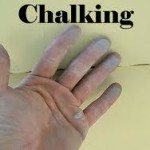
This is a very important question, especially if you live in the hot arid areas.
The first step is to understand how the chalking occurs so you can avoid it or prolong it as much as possible. Chalking is created when the binding agent in paint begins to deteriorate. In Venice Florida, the general causes for this is our over-bearing, summer sun. Take the sun and add to it a thin layer of paint or worse, a cheap, thin layer of paint and you can expect chalking paint in 2 years. Oh, and yellow is the worst.
Chalking is even caused from aplying interior paint to the exterior of your home. Big no-no.
No paint can completely prevent chalking, but different paint can prolong the chalking for 10 years! ( It pays big in the long run to buy the good stuff, e-mail me for details! steve@burnettpainting.com)
SOLUTIONS:
-Rent a 3000 psi power-washer and blast the snot out of your home! Go ahead and lay into it; you won’t hurt it. It can handle Florida hurricanes. You may need to wash twice in order to make sure chalk residue has been removed.
-While power-washing be sure to treat your mold on the North side of your home before you blast it off.
-Allowing the surface to dry for 12-24 hours
-Now most important is to first apply a “Chalk Sealer” to the entire painted surface.
-Allowing the surface to dry for 12-24 hours (De Ja Vu ?)
-Apply you top coat of premium paint to the entire painted surface.
Done properly and with the right paint brand and line you will be in great shape for 10 plus years!
Please feel free to comment and share your Chalking stories.
-You may need two coats of paint, and while this requires more work and is a bit more costly, it is worth it to avoid having to repaint in the near future.
-Always use good quality paint. Compare the concentration of solids in different paints. Liquid (water) evaporates over time, so what you are left with are the solids. “Solids” include additives, binding agents, and pigment. A high concentration of solids usually insures a thicker coat of paint and better coverage. Avoid paints with high concentrations of both water and pigment that contain low percentages of other solids.
-If you are unsure, seek advice from a professional or obtain a recommendation from a customer service representative at your local paint store, home center store, or hardware store.
Serious chalking will erode and thin the layer of paint and as stated can stain other surfaces, so if you have a chalking problem you should treat it immediately.
Thanks to Guest Blogger Steve Burnett at Burnett Painting for this informative article.

Regarding Chalking Paint: You didn’t say what to seal it with. One of the things that can be used is Peel Stop from Zinzser, but it can be a bit pricy. I have found that there is a Milky, almost water like consistency product called “Bond / Prep that is really easy to apply (pump sprayer or backpack sprayer). Make sure to get the right one. It is sold by Glidden (now “PPG” or Pitsburg Paints). At one point they had a bad batch that didn’t work properly, but I got them to replace it. I would do a test area by applying to a small area and waiting for it to dry. The surface should be shinny or it’s not working. Don’t buy too much product and try to store it because it will go sour. If it smells sour, don’t use it. I’d be interested to know of any similar products, but when I ask for them at My local SW store, they look at me with a blank stare. Don’t get me wrong, SW is usually pretty knowledgable as far as paint stores go.